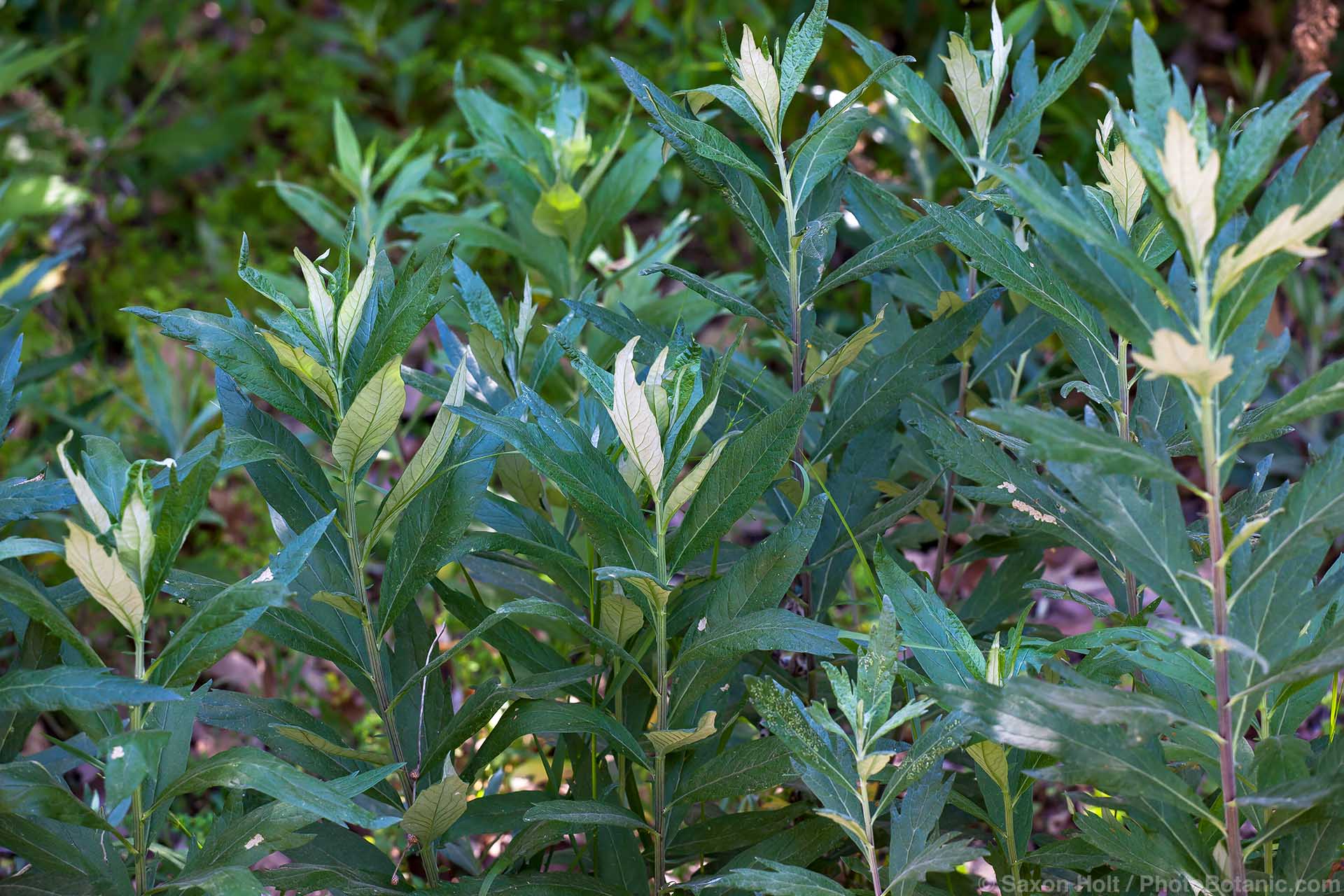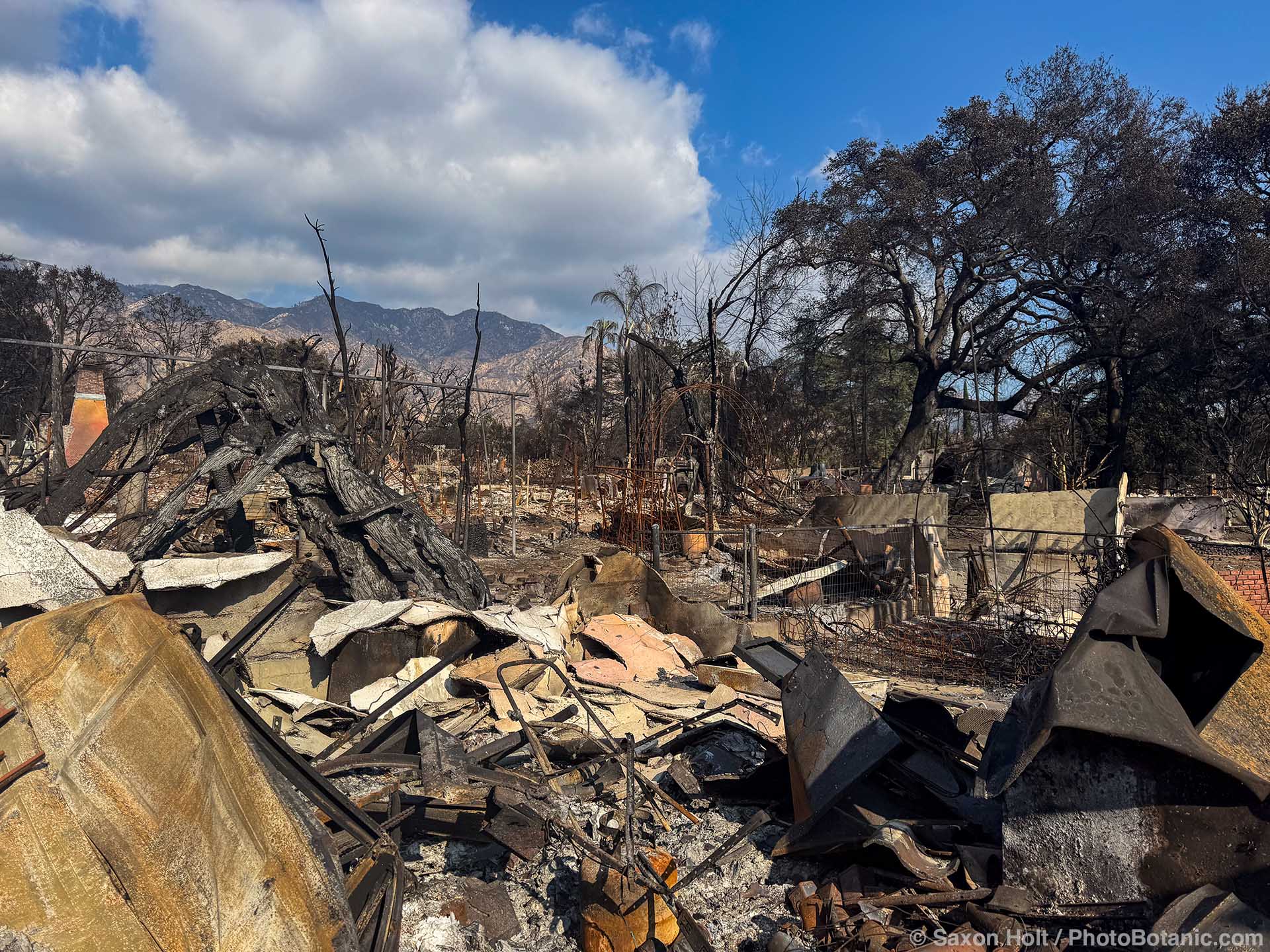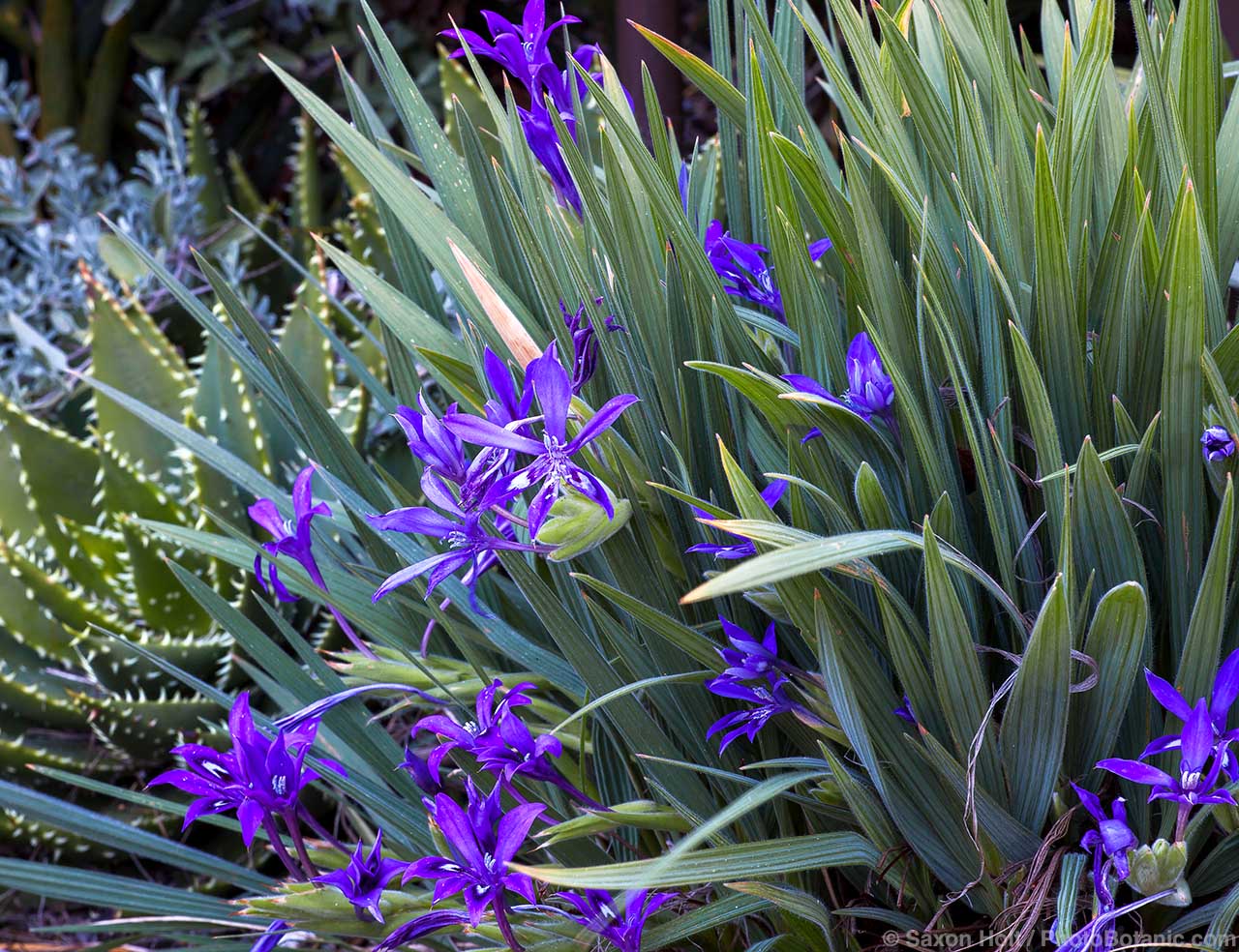Ericas for Mild-Winter Summer-Dry Climates
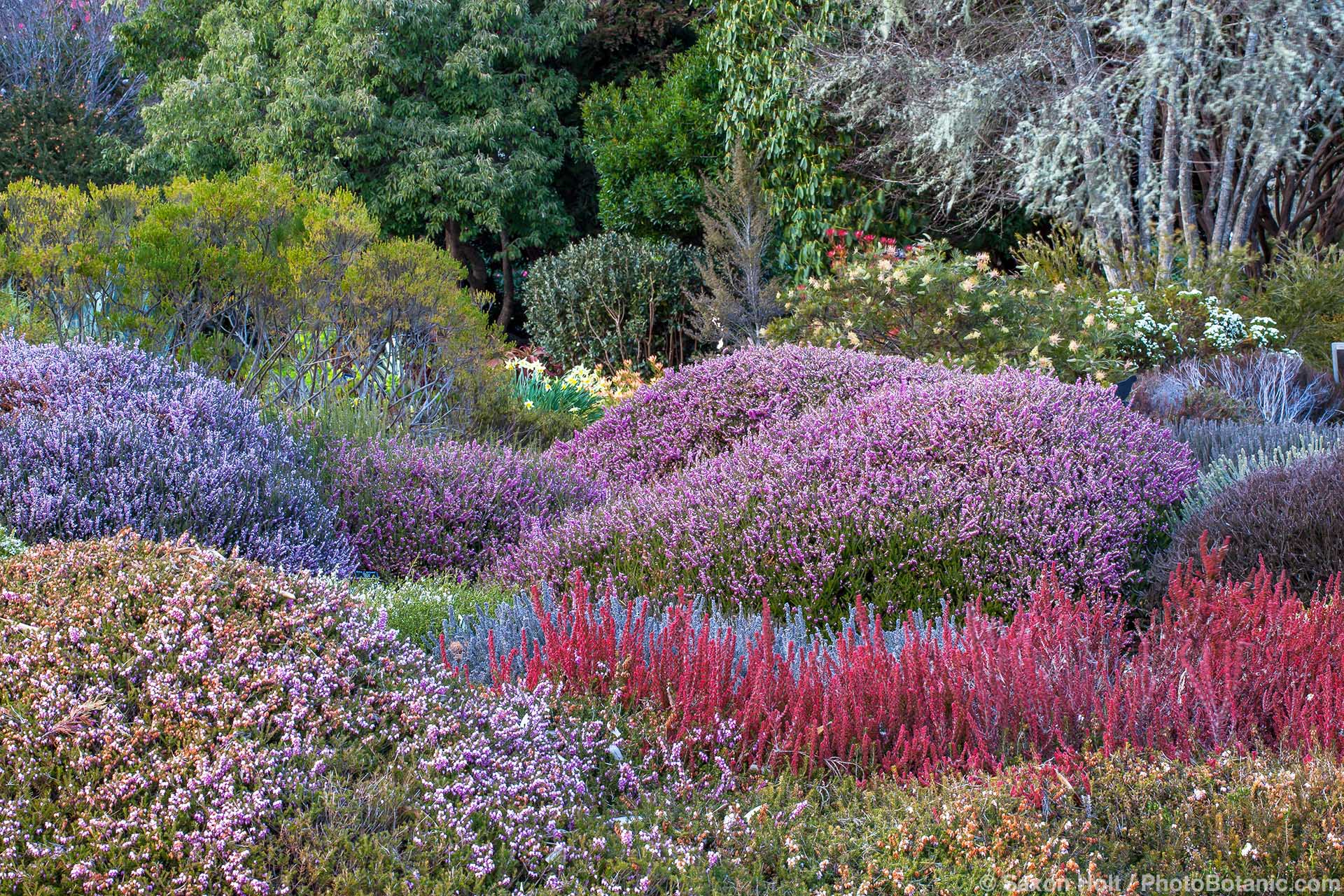
Share This!
So, your summers are reliably dry, warm to hot, and sometimes, if only briefly, scorching. Your winters are usually wet and chilly but sometimes, briefly, icy cold. Years of drought and winter downpours both are common. Your soil is partly or mostly clay. Can you grow ericas? The short answer is maybe.
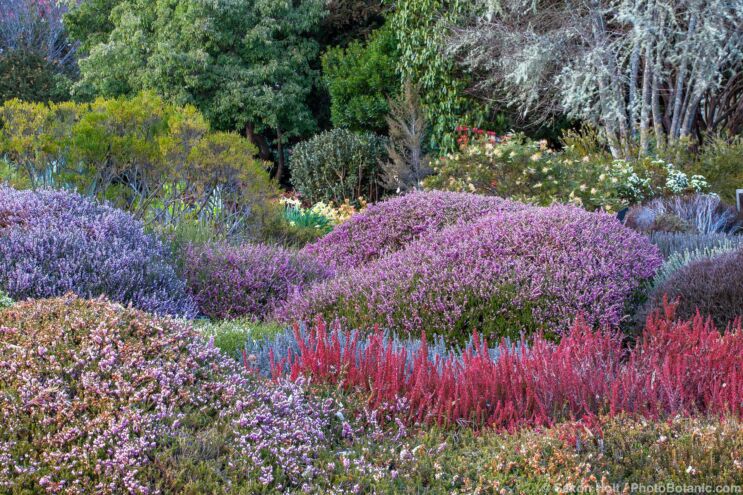
Ericas from South Africa in the Mendocino Coast Botanical Gardens, Mendocino County, California
Ericas are native to a long but fairly narrow band from Norway south to Portugal, Spain, and northern Morocco, east to Turkey and Lebanon, and south to the southernmost tip of Africa. Climates and soils in which ericas are naturally found thus vary widely.
Most of the ericas available to gardeners today are cultivars of species of European origin. Many are named varieties of three species native to the snowy mountains and misty moors of western Europe: Erica carnea, E. cinerea, and E. erigena (the latter usually as E. x darleyensis, a hybrid with E. carnea). Dozens of others can be had, but only from specialty nurseries or botanical garden plant sales.
European ericas are mostly low-growing, winter-blooming shrubs with small to tiny, urn- or bell-shaped flowers in various shades of pink or purple, sometimes white. Most grow best in full sun in moist, well-drained, acidic soils. Most are quite hardy, unfazed by cold winter temperatures. Although heat tolerance can be pushed with enough water and afternoon shade, many European ericas fail to thrive where summers are hot and dry.
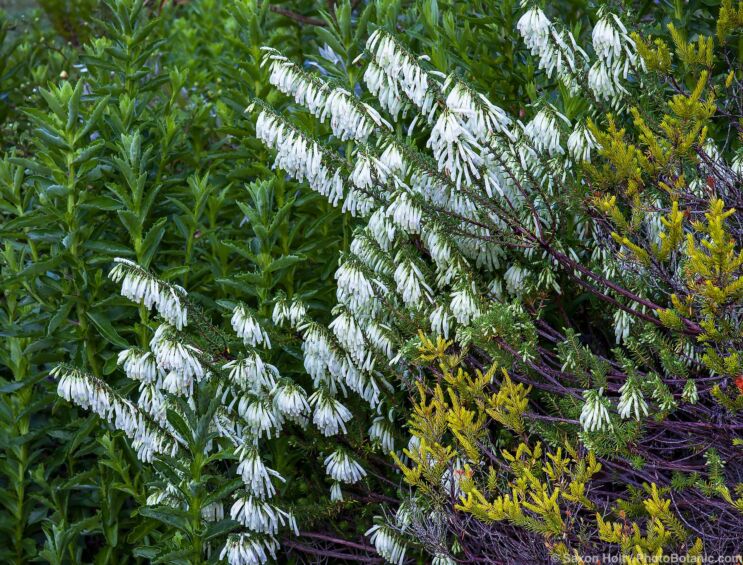
Erica mammosa, native to South Africa, in San Francisco Botanical Garden
There are alternatives. European ericas represent a small fraction of the world’s erica species. Of about 850 species worldwide, only 20-some-odd are found from northern Europe through the western and eastern Mediterranean. Ten more are found in small and scattered populations in the mountains of eastern Africa and about 45 are native to Madagascar and the Mascarene islands. The overwhelming majority, more than 750 species, are native to South Africa, almost all to the Western Cape.
South African ericas are a varied lot. As with European species, most are low to mid-sized shrubs with short, narrow, needlelike leaves that can be difficult to differentiate when out of bloom. In flower is when the South Africans shine. Flowers are generally larger and more varied in shape and color than those of European species. They bloom at different times of year and come in shades of every color except blue.
The wide variety of flower shapes, colors, and flowering seasons is thought to be a targeted evolutionary response to the varied pollinators that sustain these plants. While European ericas are pollinated primarily by bees, South African ericas attract distinctly different specialized pollinators, including flies, moths, and beetles, long-beaked, nectar-feeding birds, and even small rodents. Birds are drawn to brightly colored tubular flowers. Plants bearing tiny, open-mouthed flowers with protruding anthers are pollinated primarily by wind.
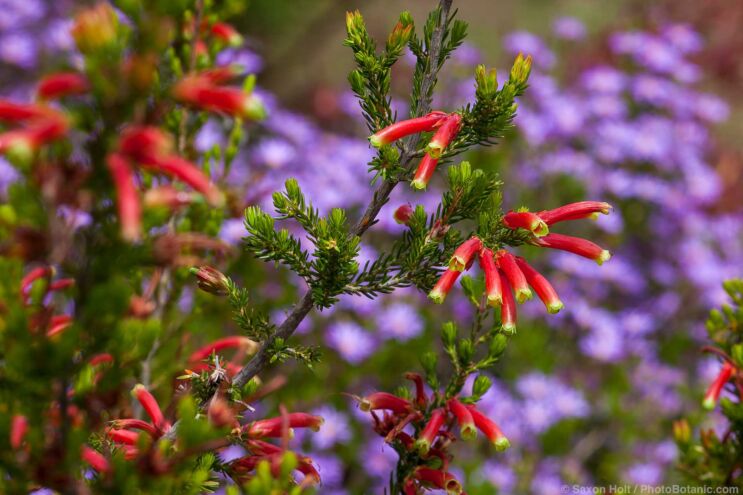
Erica discolor (E. speciosa) has tubular, bicolored flowers popular with long-beaked birds.
South African ericas in general are adapted to warmer summer temperatures and so hold promise for gardeners in warm to hot summer-dry climates. Many, if not most, however, are not cold hardy and tolerate only a few degrees of frost.
Documenting cold hardiness of warm-summer ericas is an area of considerable interest to the horticultural community. Just as there are European ericas that are better adapted than most to hot, dry summers, there are South African species that are more tolerant of cold. These are suitable for warm-summer climates with winter temperatures that rarely drop below 28 degrees F., never for prolonged periods. The hardiest South African ericas can survive brief drops to the low 20s.
Erica glandulosa is said to be one of the hardier South African ericas. This is a variable and long-lived plant that is found in both mountains and lowlands in southern and western parts of the Eastern Cape into the eastern Western Cape. Subspecies glandulosa is the plant most widely distributed in the wild and the one most often grown in gardens. Up to 4-5 feet tall with pink to orange, sometimes yellow, tubular flowers almost year-round, it survives hot, dry summers and is hardy to the low 20s.
Erica mammosa is a slow-growing, long-lived, upright shrub, 3 to eventually 6 feet tall, with long, tubular, late summer and fall flowers in various shades of pink or red to greenish white or white. This shrub has a wide distribution in the Western Cape from sandy flats at sea level to higher mountain slopes. Tolerant of temperatures down to the low 20s, it is also fairly drought tolerant once established. ‘Winter Fire’ is a slightly more tender hybrid with E. oatesii, a red-flowered species native to mountains of eastern South Africa.
Erica canaliculata is another widely distributed species, found along the Garden Route on the south coast from the winter-rainfall Western Cape to the summer-rainfall Eastern Cape. This is one of several “tree” ericas that, where conditions are ideal, can reach 10-12 feet tall. It grows both on sandy flats in full sun and in part shade at the margins of indigenous forests. Its small, pink, bell-shaped winter flowers have a distinctive fragrance. This species is moderately cold hardy and tolerates heavier soils as long as they are well drained and plants are not overwatered.
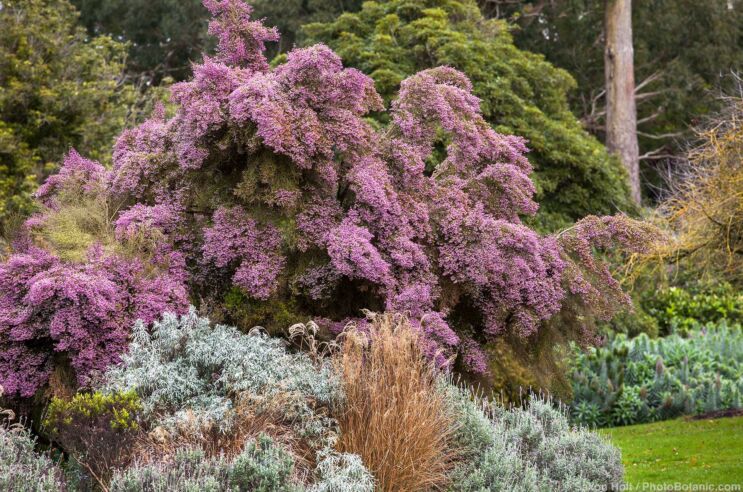
Erica canaliculata flowering in the San Francisco Botanical Garden
Erica discolor (E. speciosa) is a common and variable species 3-6 feet tall with pink to dark red-orange, slightly curved, tubular flowers with pale yellow to white tips at almost any time of year. It is widely distributed on inland mountain slopes and coastal hills and flats in the southwestern and southern Cape. Plants tolerate brief exposures to temperatures in the mid- to low 20s.
Erica verticillata is an upright shrub, 3-5 feet tall, with tubular, rose pink to dark purple tubular flowers in summer. Native to damp, sandy flats on the Cape Peninsula, it is hardy to the low to mid-20s and once established needs little summer water along the coast. ‘African Fanfare’ is a popular hybrid cultivar 2-3 feet tall. Many other cultivars are sometimes available.
Several other South African ericas have been found to be quite cold hardy and more undoubtedly will be identified. Erica hybrida, E. cerinthoides, and E. baueri are a few of the species that survive temperatures in the mid- to low 20s. E. baueri, and especially the subspecies baueri, accepts moderate frost, some drought, and a range of soil types. With gray-green foliage it bears clusters of pink or white, tubular flowers in winter to late spring or sporadically all year.
And finally, despite the near-universal caveat that ericas must be planted in acidic soil, there are ericas that grow naturally in alkaline soils and others that prefer acidic soils but are adaptable enough to be grown in clay. Adaptable plants from Europe and the Mediterranean include the many cultivars of Erica x darleyensis. Some cold-tolerant South Africans that can be grown well in heavier soils include Erica baueri, E. canaliculata, and some of the many cultivars of E. verticillata.
Most South African ericas that naturally grow in alkaline soils are native to limestone fynbos, a type of vegetation adapted to limestone outcrops. At least a dozen ericas are endemic to limestone-derived soils, including Erica calcareophila, E. baueri subsp. gouriquae, E. irregularis, and E. spectabilis. These and others are found mostly along the south coast from Cape Agulhas to the Breede River and inland to Bredasdorp as well as farther east from Puntje to just south of Albertinia. These species are not yet commercially available, but soon may be as the horticultural potential of rare and endangered limestone endemics becomes more widely recognized.
If all else fails, many ericas are successfully grown in pots, where sun, soil, and moisture can be controlled and plants can be moved into protected locations if temperatures fall too low. Fill a suitably large container with a fast-draining soil mix and keep close watch on soil moisture. Pots need watering much more often than plants in the ground, but few ericas can survive long in waterlogged soil. In pots as in the garden, most ericas need annual tip pruning to maintain good form and to continue their prolific flowering.
Share This!
Related Articles
By: Nora Harlow
By: Saxon Holt
By: Nora Harlow



